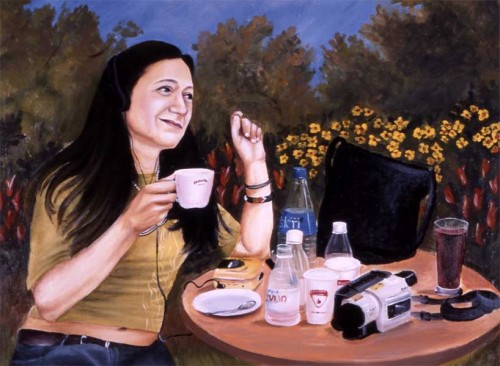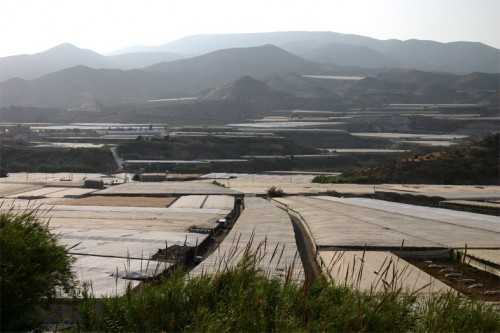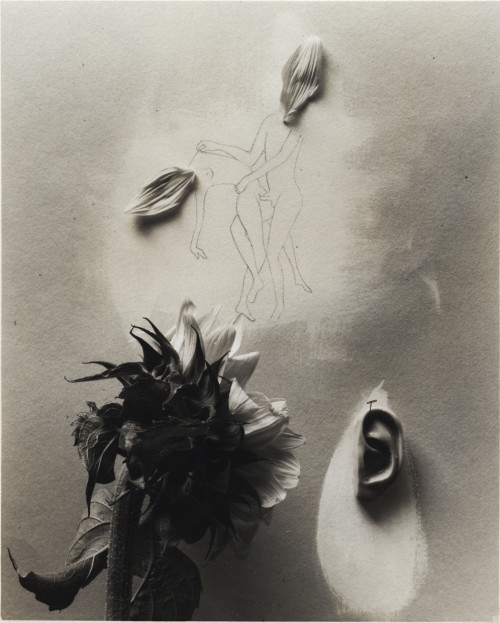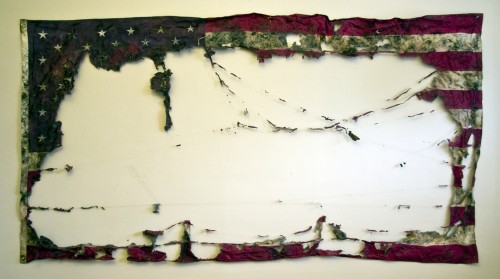
"The Dream," one of four paintings commissioned by the artist painted by Suhana Art Studio, Bombay, India.
The first time I encountered Claire Pentecost was at the 2nd annual Creative Time Summit in 2010, where she was a keynote speaker for a panel on “food politics.” What was immediately striking to me about the artist was her grace and intelligence. In her presentation, she examined what was at stake among a movement of artists who have chosen to investigate the relationship between food production/distribution, ecology, and geopolitics. Unlike the majority of the presenters at the Summit, many of whom ran out of time, at the end of her presentation Pentecost had time to spare. This to me speaks to her “way,” which patiently and deliberately uses art as a framework to map what Brian Holmes calls (after Deleuze) our “control society,” a society ruled by the cruel partnership of corporations and governments.
Since the late ’90s, Pentecost, along with a number of artists such as those associated with the Critical Art Ensemble, have sought to use art to politicize and create public knowledge around the production, distribution, and consumption of food. This long-term research project engages what Pentecost calls the “Public Amateur,” whereby artists inhabit the position of amateurs and hobbyists in order to make visible our everyday relationships with techno-scientific processes. The advantage of the amateur, for Pentecost and others, is that one can enter specialized discourses in order both to reveal how those discourses function (that is, to demystify them) and to empower others to think about how science and technology function in their daily lives and in the public sphere at large. What’s more, since the amateur is not inside the discourses of techno-science, but rather an intruder into those forms of knowledge production, they may possibly see more clearly a series of relationships between corporations, public and private institutions, governmental agencies, and the everyday practices of consumers, producers, and citizens. (Scroll down the following article to see Pentecost’s diagrams outlining the uses for public amateurism: https://transform.eipcp.net/transversal/0507/pentecost/en.)
Through such projects as Public Amateur, Pentecost redefines visual art’s value for intervening in the public sphere. Instead of maintaining their value as commodity fetish, art works take on a socio-political function, enabling citizen-artists to “think what we are doing” (Hannah Arendt). The result of much of Pentecost’s art is documentary in nature. It documents places she has traveled, and presents ways that photography in particular can correlate and mediate sites of biopolitical production. Through her documentary-research practice, she takes up Robert Smithson’s dialectic between “site” and “nonsite.” What has changed between Smithson’s and Pentecost’s eras is the nature of sites, where sites are more than ever things often unseen to the “naked eye,” occluded by mass media and geographic displacement (off-shore production or detention, for instance). In projects like Plastic Greenhouses by the Sea (2005), Pentecost maps the occlusions and displacements of a social landscape, documenting how labor practices and tourism interact through the industrial agricultural processes of southern Spain, where much of the greens of Europe are cultivated. In this photo series the view changes whether you are looking at the Mediterranean from above a luxury hotel, or just beyond the hotel where the white trap-covered greenhouses lie. Other photos show us worker’s shacks, highlighting the relationship between labor exploitation, food production, and touristy.
Another project of Pentecost’s that seems exemplary of her practice is the newspaper The Grub Heap Kernel, published in April, 2006. Like a “real” newspaper, the GHK includes ads, cartoons, obituaries, op-ed, even poetry, only with a significant twist. The ads are for made-up businesses, and often read more like Buddhist koans or texts by Gertrude Stein (which they very well might be). They also contain Adbusters-style anti-consumerist messages. The obituaries are for corporate personhood and other bad ideas of our corporate-oligarchic democracy. The op-ed is clearly written by Pentecost, as I suspect much of the newspaper is, despite the use of heteronymns such as “Richard Bong” and “Marionette Beecraft.” In the spirit of the Yes Men’s New York Times jam in November, 2008, Pentecost brings us news that intends to transform our practices. She also drops a fair bit of knowledge gleaned from an extensive reading practice that, in the spirit of Public Amateur, wishes to provide us with useful knowledge and demystify rarefied technical processes.
Another practice of Pentecost’s, quite different than those previously described, though no less integral, involves a series of works produced in a derelict studio rented by the Chicago-based artist, Interior Studies. What is unique to me about these works, and perhaps a reason why Pentecost is reticent to prioritize them among her more research-based and activist works, is their combination of neo-surrealist techniques (automatic writing, exquisite corpse) with political content (on multiple works one sees the heads of Bill Clinton and George W. Bush, as well as a series of other recognizable political icons). What is also unique about these photo prints is the way they confuse photographic, sculptural, installation, and drawing processes. Like tableaus or perverse still lives, Pentecost arranges a series of objects, bodies, and drawings, obscuring figure and ground, erasing or removing elements for subsequent photographs. The studio becomes a ghostly palimpsest as the artist carves into the doorframes and writes on the walls. The result is a new form of writing, not merely mechanical or haptic, but both. The illusionism and serendipity of these works, as Pentecost points out, mark a literal moment of interiority in her work, as though the intensive unconscious processing her studio practice involves potentialized her more visible research and critical writing practices, as well as her roles as an activist and public intellectual.
1. What is your background as an artist and how does this background inform and motivate your practice?
I was raised in Atlanta, Georgia, and from many southern factors a provisional narrative emerges.
Raised Christian and sent to a Christian school I have to say that the teachings of jesus (!) contributed a lot to my moral psychology—the sense that every human deserves our respect, that the life worth living is about cultivating love, and that you can’t do better than hanging out with the outcasts and repudiating the dominant normative value systems.
Rosa Parks kept her seat the year before I was born, so my earliest years coincided with the Civil Rights movement. Witnessing the shake up of historical social foundations in my own world opened a vast horizon of possibility. In high school I wrote a paper on the Black Panthers, sympathetic but naïve, but this is an example of something I find interesting in so many lives—what makes people seek out things that their immediate world does not support? What gives a person the motivation and courage to veer from the terms expected of them? In this and other regards Malcolm X is one of the most inspiring people in history. And this is why we have to make resistant culture visible.
Meanwhile, my grandparents had this magical farm just outside the city, which, as my grandparents aged, became a neglected rambling playground full of enchanted abandoned places, a robust elsewhere set in “nature.” We lost it, and I subsequently mythologized it, leading me much later to explore cultural constructions of what we call nature. I examined concepts, institutions and myths that mediate our relationship to the rest of the natural world, including national parks, zoos, natural history museums, the romanticization of Native Americans, the decadent movement, literature of exploration, photography itself. Only after about 10 years into this, it dawned on me to include agriculture and food in this inquiry. And so I return to the site known in my family as “the farm.”
After college I became a community organizer in North Carolina. Our vision was to build a racially integrated power base for the working poor. This was a formative, engrossing experience but I missed something and I quit organizing to paint. Starting from an archaic notion of art, it took me years to figure out how to combine my need to do something creative with my drive to respond more vigorously to our biocidal culture.
2. Do you feel there is a need for the work that you are doing given the larger field of visual art and the ways that aesthetic practices may be able to shape public space, civic responsibility, and political action? Why or why not?
So much is needed, it’s a challenge to determine where to focus. The way to make a sustainable practice is to structure one’s contributions within the scope of one’s own needs and proclivities but with the aim of self-surpassing. So my work responds to my own needs, desires, and outrage, but as I am a part of my culture I assume that my needs have some relation to those of others.
Because so much is going disastrously wrong under the machine of Western global imperialism, I ponder continuously why people aren’t reacting more forcibly. There is a lot of resistance in the global south, but as our own culture’s prosperity depends on other people’s immiseration, most resistance here is directed against comprehending our position! In general there is a purposeful, structured ignorance in our country—in the most comprehensive sense—and this is constitutionally disempowering.
In many ways my need to know and explore how the world works is my art. I think this is partly why I have developed the idea of the public amateur: the artist as someone who learns in public, putting the production of knowledge itself up for scrutiny. Why is the production of knowledge so important? It’s not only because knowledge is partly what determines one’s position in relation to risk, but also because the expertise of authorities has for the most part failed to manage the risks of a technological society (part of the Occupy movement derives from this recognition). It becomes increasingly clear that no one is going to save us and we have to work together to experiment with new ways of being in the world. For this we have to return knowledge to the realm of the social by producing knowledge collectively. We have to start with “I don’t know,” and proceed to think across disciplines to propose alternatives to a system founded on violence against life.
A complex culture needs many different kinds of art, and a given artist may find that she also needs to do different kinds of art. A lot of what I do is research-based and constitutes a model of living and encountering knowledge. This work is often lean on product except for writing, documentary style photographs, lectures and discussions. But in another dimension I also maintain a studio practice in which I make drawings on the wall and photograph them at different stages, then print them in a 19th century palladium process. (See for instance, https://www.higherpictures.com/artists/Claire_Pentecost/).
3. Are there other projects, people, and/or things that have inspired your work? Please describe.
I hate this question. It can’t be answered adequately. I will leave books aside.
Since I am ruled by a desire to learn and to learn is to be changed, I have let myself in for a lot of changes. One watershed experience that marked a before and after was the Whitney Program. This introduced me to many intellectual tools for continual questioning, synthesizing, and questioning again. Of course I have benefited from knowing countless amazing artists outside the hegemony of this one program, but that experience happened to galvanize my own approach to life and art.
Attending the World Social forum in Mumbai, Caracas and Nairobi was enormously significant for me, confirming the existence of a realm of grassroots resistance and a widespread desire to change the global premise of social and natural relations. Similarly, joining the protest of the 2003 WTO ministerial in Cancun made the effects of geopolitical arrangements bracingly clear to me. Again, we have to raise the visibility of struggle and alternative propositions so that people looking for something different can find it.
I feel enormous gratitude toward people who continually recreate and enrich the artistic territory of my particular interests, Mierle Laderman Ukeles, Agnes Denes, Nance Klehm, Betsy Damon, Mark Dion, Critical Art Ensemble, Amy Francescini, Natalie Jeremijenko, SubRosa, and also toward others who do very different work but who make me want to stay in the game: Platform, John Jordan and Isa Fremeaux, Temporary Services, 16Beaver, Laurie Palmer, Sarah Lewison, Laurie Jo Reynolds, Jennifer Montgomery, Dara Greenwald, Ashley Hunt, Amar Kanwar, Lauren Berlant… I shouldn’t have started because I will never finish. And my students over the last 14 years have been an ongoing source of inspiration.
Recently, I have been most recharged by social movements in Detroit, Timothy Morton’s writings on “ecology without nature,” Wikileaks, and the prison abolitionist movement. All of these challenge the core of the contradictions we are expected to tolerate.
4. What have been your favorite projects to work on and why?
Since 2006 I have been working with my partner Brian Holmes and sometimes 16Beaver and always many, many others, on a project called Continental Drift. It started as an effort to understand the concrete manifestations of the abstractions that shape globalization and how oppositional efforts are identifying points of leverage in the system. It became a capacious structure for collectively examining an ethics of scale from the local to the global. In 2008 I was feeling a peculiar isolation, an ignorance of my own environment, who and what make the territory that sustains my life. A group of us in the Midwest devised a 10-day traveling seminar, the content of which would derive chiefly from the locations and situations we encountered. This included lectures, discussions, meals, screenings, walking tours, farms, cooperatives and a commune (Dreamtime Village). We have continued to explore the Midwest together and are now just finishing our second book. With a changing cast of characters we did versions of this kind of trip in Argentina and China.
I love these journeys because they involve embodied research, engaging the full human sensorium. This is aesthetics. Lived experience provides a different purchase on knowledge. I am very motivated by “the act of seeing with one’s own eyes.” When that experience is shared with other people, the understandings are multiplied. Most of us are so out of touch with the systems that sustain us that we can benefit by doing this research within a short radius of our homes.
5. What projects would you like to work on in the future? What directions do you imagine taking your work in?
Right now I am studying soil science, which is thrilling! Underground is a marvelous living complexity. I am about to embark on a project that starts with making soil, goes on to question the basis of our value system—now petroleum but why not soil?—and branches also to constructing vertical growing systems to produce vegetables in mean urban spaces.
Several members of the collective Compass are staging public hearings on the crimes of Monsanto. We are doing this in several Midwest locations, beginning in Carbondale, IL.
I am feeling the need to involve myself in a long-term located project where I live. One of my fantasies is setting up a node in an alternative educational structure. As it is now, education is becoming theft—in the form of student loans that enslave people for lifetimes.












Pingback: Talking Sticks: Communities of Practice | Talking Sticks: Communities of Practice
Pingback: SUELO: Sobre Prácticas Artísticas, Ecología y Sociedad – On Artistic Practice, Ecology & Society | Estudio Nuboso
Pingback: Claire Penticost | anticedent
Pingback: Claire Pentecost | what to expect when you're least expecting